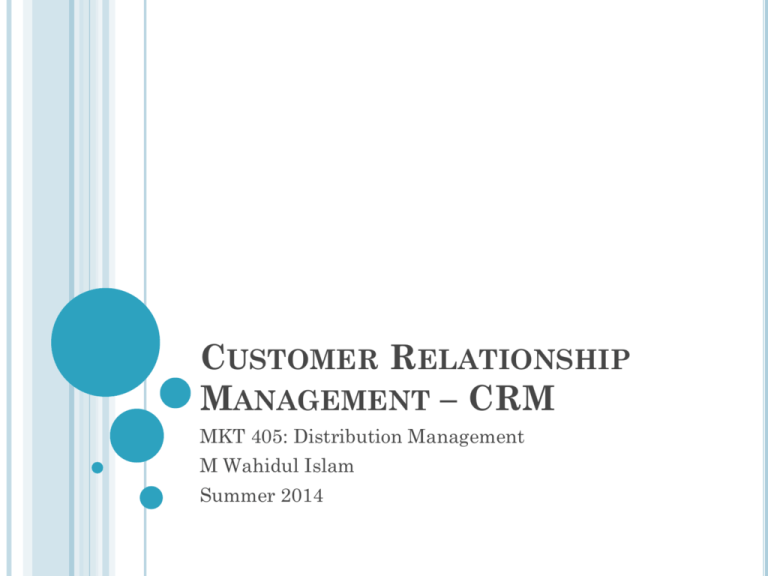File - MKT 405 Distribution Management
advertisement

CUSTOMER RELATIONSHIP MANAGEMENT – CRM MKT 405: Distribution Management M Wahidul Islam Summer 2014 Planning, Forecasting & Budgeting Warehousing and Logistics Channel Information Systems Sales Force Management Elements of Distribution Management Distribution Channels Product Pricing and Promotion Product Visibility CUSTOMER RELATIONSHIP MANAGEMENT – CRM Traditionally the word CRM is used to refer to relationship management with End Customers Objective of CRM Build End Customer Loyalty Loyal customer refers to someone, Who is most likely to make repeat purchases Who will resist the activities of competitors attempting to attract patronage CUSTOMER RELATIONSHIP MANAGEMENT – CRM Applying the concept of the CRM to Distribution Channel CRM Objective Channel Partner Loyalty THE CRM PROCESS Collect Customer Data Implementations Analyze Develop CRM Programs COLLECTING CUSTOMER DATA Foundation Customer for subsequent CRM activities Data Warehouse Numerical Data Intangible / Qualitative Data Numerical Data • Transactions / sales data • Market share • Company investment Intangible / Qualitative Data • Preferences • Attitude towards the company • Responses to marketing activity DEVELOP CRM PROGRAM ANALYZING CUSTOMER DATA Data Mining Technique used to identify patterns in data, typically patterns that the on mere observation may not reveal. Market Basket Analysis Specific type of Data analysis that focuses on the composition of the shopping basket, or bundle of products purchased by a household during a single shopping occasion. Analyzing the composition of the retailers order pattern Identifying Market Segments Segment channel members based on need / profile / location The Objective is to Identifying Best Customers ANALYZING CUSTOMER DATA IDENTIFYING BEST CUSTOMERS Lifetime Value Contribution to company’s overall profit over the entire relationship Customer Pyramid 80 – 20 rule Example: Platinum > Gold > Iron > Lead RFM Analysis Recency, frequency, monetary How recent they have made a purchase? How frequent they make purchases? How much they bought? Frequent Shopper Program Community Customer Retention (Loyalty) Special Customer Service Personalization The Objective is to convert a good customer into the BEST CUSTOMER REFERENCES Chapter 11 – Customer Relationship Management Levy M. and Weitz B. A.(2004) Retailing Management (5thEdition)New York: McGraw- Hill Companies, Inc. END







